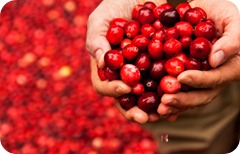 Here is another recent study on the urinary antimicrobial effects of cranberry. This study evaluated 20 adults who did not have an active urinary tract infection, and were not taking antibiotics. In phase 1 of the study, individuals collected first morning urine prior to ingesting 3 caps that contained 275 mg of a mixture of dried whole cranberry extract and 25 mg of a concentrate of cranberry extract. Urine was then collected at 2, 4 and 6 hours. In phase 2, individuals collected urine on 2 consecutive days with no cranberry on day 1 and 900 mg of cranberry preparation on day two.
Here is another recent study on the urinary antimicrobial effects of cranberry. This study evaluated 20 adults who did not have an active urinary tract infection, and were not taking antibiotics. In phase 1 of the study, individuals collected first morning urine prior to ingesting 3 caps that contained 275 mg of a mixture of dried whole cranberry extract and 25 mg of a concentrate of cranberry extract. Urine was then collected at 2, 4 and 6 hours. In phase 2, individuals collected urine on 2 consecutive days with no cranberry on day 1 and 900 mg of cranberry preparation on day two.
Results: In phase 1, 7 of 20 (35%) individuals had anti-microbial activity against Escherichia coli, 13 of 20 (65%) had anti-microbial activity against Klebsiella pneumoniae and 9 of 20 (45%) against Candida albicans. In phase 2, 23% showed antimicrobial activity against E. coli, 33% against C. albicans and 67% against K. pneumoniae.
Commentary: This study suggests that the anti-microbial activity of this cranberry extract was not significant for E. coli and that the most frequent anti-microbial activity occurred in both phases for only K. pneumoniae.
While not all studies of cranberry have shown significant antimicrobial effects, other studies of cranberry and urinary tract infections have been more positive. The current study did not study individuals with an active infection but their urine was inoculated with the three organisms and then the anti-microbial effects of the cranberry ingestion was measured as effective if there was a 50% or greater reduction in colony forming units.
It may be that a true anti-microbial effect and colony reduction of cranberry is not the main mechanism of action, but rather the ability of the cranberry to inhibit the adherence of the bacteria to the cells lining the bladder and the urethra and thus being flushed out of the urinary tract system. In addition, I would always recommend other key bladder infection ingredients in an acute treatment plan as well as a prevention of recurrence plan that would include Oregon grape root, pipsissewa, buchu, uva ursi, marshmallow root and Lactobacillus species that dominate the urogenital tract.
Reference:
Lee Y, Najm W, Owens J, et al. Anti-microbial activitiy of urine after ingestion of cranberry: a pilot study. Epublication prior to print publication: eCAM 2010;7(2):227-232 doi:10.1093/ecam/nem183

